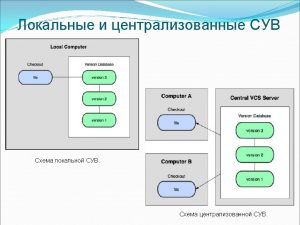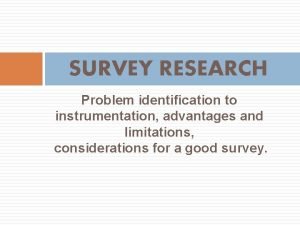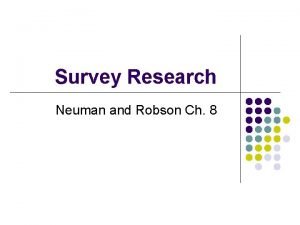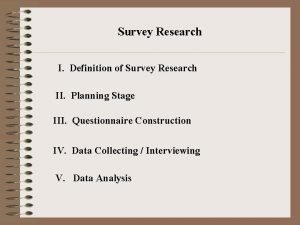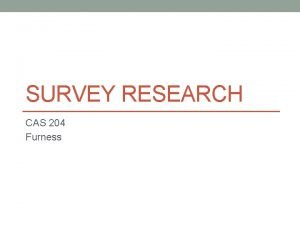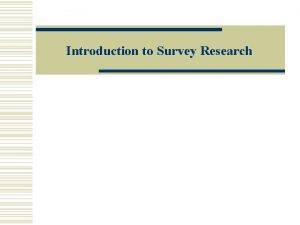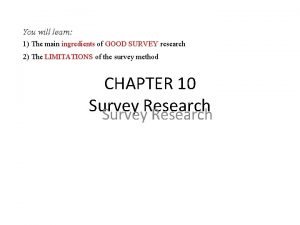SURVEY RESEARCH YOUR NAME Survey Research is a

























- Slides: 25

SURVEY RESEARCH YOUR NAME

Survey Research is a specific type of field study that involves the collection of data from a sample of elements (e. g. , adult women) drawn from a well-defined population (e. g. , all adult women living in the Philippines) through the use of a questionnaire. Visser, P. S. , Krosnick, J. A. , & Lavrakas, P. J. (2000).

Survey Research is a set of procedures in quantitative research in which investigators administer a survey to a sample or the entire population of people in order to describe the attitudes, opinions, behaviors, or characteristics of the population. Philips, P. P. , Philipis, J. J. , & Aaron, B. (2003).

“Conducting surveys seems simple enough: ask people questions, record their answers, and report the results. Even Roman Emperors polled their citizens in ancient times. ”

How did survey research develop? • During the Middle Ages, respondents to surveys typically consisted of the clergy or nobles who reported the numbers and living conditions of their parishioners or serfs. • In the 1800 s, Fabian socialists and Karl Marx relied on key informants (factory owners or trusted socialists) for information on working conditions of the poor. • Henry Mayhew, an English philosopher and social reformer, conducted sophisticated surveys of living conditions in London in the early 19 th century and asked ordinary people to report on their situation. • The social reformist surveys undertaken by the Victorians typically interviewed 10, 000 – 20, 000 individuals to ensure representation. Statisticians have since demonstrated that it is unnecessary to sample 20, 000 people to produce an unbiased idea of their economic situation or opinion.

How did survey research develop? • In the mid 1930 s, communication networks rapidly expanded throughout North America. Air travel greatly enhanced postal networks, and the telephone became a common household appliance. These developments allowed pollsters such as George Gallup to contact large subsets of the population. • New techniques are emerging in survey research. The Internet has become a powerful method of gathering information from consumers; voice recognition software allows businesses to offer rewards to consumers who call in to respond to surveys throughout the day. • Researchers now sample respondents from company databases, and survey information is collected in exchange for rewards or even cash payments. Market research and opinion polling will survive; too many managers need the information. Innovations will continue to modify the methods.

When is Survey Research appropriate? Survey research is appropriate means of gathering information under three major conditions: a) when the goals of the research call for quantitative and qualitative data, b) when the information sought is specific and familiar to the respondents, c) when the researcher has prior knowledge of the responses that are likely to emerge

Characteristics of Survey Research DESCRIPTION. It can be used to describe phenomena and summarize them. Also, the usual goal is to get a precise measurement of such phenomena. CAUSAL EXPLANATION. It measures associations between variables; e. g. , school grades and self-esteem. EVALUATION. It can be useful for determining the degree to which a desired objective is attained as a result of a planned program, hence surveys after interventions. PREDICTION. Survey data can be used to forecast future events. Polland, R. J. (2005). Essentials of Survey Research and Analysis

SURVEY RESEARCH DESIGNS EXPERIMENTAL includes surveys that can be taken before, during, and after a program, event, or intervention (compares results between control and experimental groups) DESCRIPTIVE looks into the status of a given situation using a survey (examines associations of variables rather than causal relationships)

DESCRIPTIVE SURVEY RESEARCH DESIGNS TREND CROSS-SECTIONAL SURVEYS LONGITUDINAL SURVEYS COHORT PANEL MIXED SURVEY DESIGNS

CROSS-SECTIONAL SURVEY • It involves the collection of data (e. g. , number of people who hold particular behaviors, attitudes, or beliefs) at a single point in time from a sample drawn from a specified population. • It offers the opportunity to assess relations between variables, moderators of relations (on the causal processes), and differences between subgroups in a population. • Also called one-shot survey design

GENERAL FEATURES OF A CROSS-SECTIONAL SURVEY • It describes the characteristics of a large population as it makes use of large (statistically significant) samples. • It allows use of various methods of data collection such as questionnaire, structured and unstructured interviews and document analysis. • It also makes use of standardized questions where reliability of the items is determined. • Further, the findings of the study can be generalized. Owens, L. K. (2002). Introduction to survey research design. SRL Fall 2002 Seminar Series. Retrieved from http: //www. srl. uic. edu/seminars /Intro/introsrm. pdf

LONGITUDINAL SURVEYS • Generally, in longitudinal surveys, data are collected at different points in time to study changes that occur over a period of time. • With longitudinal surveys, for example, the same group of people is interviewed at regular intervals, enabling researchers to track changes over time and to relate them to variables that might explain why the changes occur.

GENERAL FEATURES OF A LONGITUDINAL SURVEY • It allows the analysis of duration of a particular phenomenon. • It enables survey researchers to get close to the kinds of causal explanations usually attainable only with experiments. • It permits the measurement of differences or changes in a variable from one period to another. • It facilitates the prediction of future outcomes based upon earlier factors. Bryant, L. (2013). Longitudinal studies: Essex historical learning site. Retrieved from www. historylearningsite. co. uk .

TYPES OF LONGITUDINAL SURVEYS TREND SURVEY samples a population (focused on trends) whose members may change over the course of the study. For example, a researcher might be interested in the attitudes of high school principals toward the use of flexible scheduling. This researcher would select a sample each year from a current listing of high school principals throughout the state. Although the sample population would change somewhat and the same individuals would not be sampled each year, if random selection were used to obtain the samples, the responses obtained each year could be considered representative of the population.

TYPES OF LONGITUDINAL SURVEYS COHORT SURVEY is conducted over a period of time involving members of a population with some commonality or similarity (Healy & Devane, 2011). Using a quantitative framework, a cohort study makes note of statistical occurrence within a specialized subgroup, united by same or similar characteristics that are relevant to the research problem being investigated, rather than studying statistical occurrence within the general population. Using a qualitative framework, cohort studies generally gather data using methods of observation. Healy, P. Devane, D. (2011). Methodological considerations in cohort study designs. Nurse Researcher, 18 : 32 -36.

TYPES OF LONGITUDINAL SURVEYS PANEL SURVEY studies the sample of a population (focused on changes) at different times during the course of the study. Because the researcher is studying the same individuals, he or she can note changes in their characteristics or behaviors, and thus, explore the reasons for these changes. However, loss of individuals is a frequent problem in panel studies particularly if the study extends over a fairly long period of time.

SURVEY RESEARCH: MIXED DESIGN CROSS-SECTIONAL SURVEYS LONGITUDINAL SURVEYS MIXED-DESIGN SURVEYS If, for example, a researcher is interested in conducting a two-wave panel survey but is concerned about carry-over effects, he or she should conduct an additional crosssectional survey at the second wave. That is, the identical questionnaire could be administered to both the panel respondents and to an independent sample drawn from the same population.

SPECIFYING A SURVEY DESIGN Cross-Sectional Longitudinal (Trend, Cohort, Panel) Mixed Design SAMPLING Probability Sampling Simple Random Systematic Stratified Cluster Nonprobability Sampling Haphazard Purposive Snowball Quota DESIGNING A QUESTIONNAIRE PRETESTING Open & Closed Questions Rating & Ranking Order of Response Alternatives Question Wording Question Order Conventional Pretesting Behavior Coding Cognitive Interviewing COLLECTING DATA Mode Interviewing Supervision Validation

SAMPLE SURVEY RESEARCH Research: Ferris, D. R. (1995). Student reactions to teacher response in multi-draft composition classrooms. TESOL Quarterly, 29 (1), 33 -53. Research Questions: (1) What does teacher feedback tend to cover and in what form is it presented? (2) How much of this feedback do students process, how do they go about doing this, and what forms of feedback might be difficult for them to interpret? (3) What (if any) differences are there in teacher feedback and what is student response to it between preliminary and final drafts? Methodology: The 155 students were surveyed during the Spring and Fall 1992 semesters using the questionnaire developed by Mc. Curdy (1992). The quantitative item responses between preliminary and final drafts were examined using a Wilcoxon Matched Pairs-Rank Text. Structured-response item responses were collated and grouped in order to examine various trends in the responses.

POTENTIAL ISSUES IN SURVEY RESEARCH QUESTIONNAIRE DESIGN • Question is unclear. • Multiple questions. • Question is wordy. • Question is negatively worded. • Overlapping responses. • Unbalanced response options. • Mismatch between questions and answers. • Question includes overly technical language. • Not all questions are applicable to all the participants.

POTENTIAL ISSUES IN SURVEY RESEARCH ISSUES IN SAMPLING AND RESPONDENT SELECTION • Ethical issues and confidentiality requirements • Non-randomized respondent selection • Complex targeting and segmentation • Perceptual mapping and discriminant analysis

POTENTIAL ISSUES IN SURVEY RESEARCH NONRESPONSE It refers to members of a sample who do not respond to the instrument. There are two general types of nonresponses: Total Nonresponse : not responding to the entire survey or instrument. Item Nonresponse : not responding to some of the questions within a survey or instrument.

POTENTIAL ISSUES IN SURVEY RESEARCH THREATS TO INTERNAL VALIDITY • Mortality • Location Threat • Instrumentation (including defects in the instrument itself) • Instrument Decay (interviewers get tired/are rushed)

SURVEY DESIGN AND CORRELATIONAL RESEARCH Correlation of the results of two separate surveys (usually in longitudinal surveys) is conducted to determine if a relationship exists. Scores or results of surveys are examined in the research by calculating the correlation coefficients or by preparing contingency tables.
 What's your name? how old are you?
What's your name? how old are you? Opposite rays
Opposite rays My name is betty
My name is betty Git config global user name
Git config global user name Your conscious awareness of your own name and self identity
Your conscious awareness of your own name and self identity Give us your hungry your tired your poor
Give us your hungry your tired your poor Abcde acls
Abcde acls What is a survey research method
What is a survey research method Ch
Ch Survey definition in research
Survey definition in research Conceptual framework for descriptive research
Conceptual framework for descriptive research Descriptive survey
Descriptive survey Advantages of survey research
Advantages of survey research Chapter 5 discrete probability distributions
Chapter 5 discrete probability distributions Survey of literature
Survey of literature Descriptive survey design
Descriptive survey design Survey research advantages and disadvantages
Survey research advantages and disadvantages Steps in survey research
Steps in survey research Experience survey in exploratory research
Experience survey in exploratory research Characteristics of survey research
Characteristics of survey research Variables in survey research
Variables in survey research Definition of survey research
Definition of survey research Quantitative questionnaire
Quantitative questionnaire Survey research
Survey research Purpose of survey in research
Purpose of survey in research Descriptive survey research
Descriptive survey research



